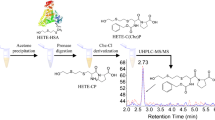Abstract
To investigate the effects of mercury species intoxication and to test the efficiency of different commonly applied antidotes, human whole blood and plasma surrogate samples were spiked with inorganic mercury (Hg2+) and methylmercury (MeHg+, CH3Hg+) prior to treatment with the antidotes 2,3-dimercaptopropan-1-ol (British Anti Lewisite), 2,3-dimercaptosuccinic acid (DMSA), and N-acetylcysteine (NAC). For mercury speciation analysis in these samples, liquid chromatography was coupled to either inductively coupled plasma mass spectrometry (ICP-MS) or electrospray ionisation time-of-flight mass spectrometry (ESI-TOF-MS). Adduct formation between mercury species and physiological thiols (cysteine and glutathione) was observed as well as the release of glutathione under treatment with the antidotes DMSA and NAC.




Similar content being viewed by others
References
Horvat M, Gibicar D (2005) In: Cornelis R (ed) Handbook of elemental speciation II. Wiley, Weinheim, pp 281–304
Bridges CC, Zalups RK (2005) Molecular and ionic mimicry and the transport of toxic metals. Toxicol Appl Pharmacol 204:274–308
Clarkson TW, Magos L (2006) The toxicology of mercury and its chemical compounds. Crit Rev Toxicol 36:609–662
Oh KJ, Park K, Kang TW, Kwon DD, Ryu SB (2007) Subcutaneous metallic mercury injection for penile augmentation. Urology 69:185e3–185e4
Varnai BM, VM PM, Kostial K (2005) Chelators as antidotes of metal toxicity: therapeutic and experimental aspects. Curr Med Chem 12:2771–2794
Andersen O, Aaseth J (2002) Molecular mechanisms of in vivo metal chelation: implications for clinical treatment of metal intoxications. Environ Health Perspect 110(Suppl. 5):887–890
International Programme on Chemical Safety (IPCS) INCHEM. Dimercaprol, Canadian Centre for Occupational Health and Safety and International Programme on Chemical Safety, 1990. (http://www.inchem.org/documents/pims/pharm/dimercap.htm)
de la Torre A, Bellés M, Llobet JM, Mayayo E, Domingo JL (1998) Comparison of the effectiveness of 2, 3-dimercaptopropanol (BAL) and meso-2, 3-dimercaptosuccinic Acid (DMSA) as protective agents against mercury chloride-induced nephrotoxicity in rats. Biol Trace Elem Res 63:1–10
George GN, Prince RC, Gailer J, Buttigieg GA, Denton MB, Harris HH, Pickering IJ (2004) Mercury binding to the chelation therapy agents DMSA and DMPS and the rational design of custom chelators for mercury. Chem Res Toxicol 17:999–1006
Ballatori N, Lieberman MW, Wang W (1998) N-Acetlycysteine as an antidote for mercury poisoning. Environ Health Perspect 106:267–271
Brandão R, Santos FW, Zeni G, Rocha JBT, Nogueira CW (2006) DMPS and N-acetylcysteine induced renal toxicity in mice exposed to mercury. BioMetals 19:389–398
Aremu DA, Madejczyk MS, Ballatori N (2008) N-Acetylcysteine as a potential antidote and biomonitoring agent of methylmercury exposure. Environ Health Perspect 116:26–31
Andersen O (2004) Chemical and biological considerations in the treatment of metal intoxications by chelating agents. Mini-Rev Med Chem 4:11–21
Madejczyk MS, Aremu DA, Simmons-Willis TA, Clarkson TW, Ballatori N (2007) Accelerated urinary excretion of methylmercury following administration of its antidote N-acetylcysteine requires Mrp2/Abcc2, the apical multidrug resistance-associated protein. J Pharmacol Exp Ther 322:378–384
Baxter DC, Rodushkin I, Engström E, Klockare D, Waara H (2007) Methylmercury measurement in whole blood by isotope-dilution GC-ICPMS with 2 sample preparation methods. Clin Chem 53:111–116
Krupp EM, Milne BF, Mestrot A, Meharg AA, Feldmann J (2008) Investigation into mercury bound to biothiols: structural identification using ESI-Ion-Trap MS and introduction of a method for their HPLC separation with simultaneous detection by ICP-MS and ESI-MS. Anal Bioanal Chem 390:1753–1764
Li Y, Yan X-P, Chen C, Xia Y-L, Jiang Y (2007) Human serum albumin-mercurial species interactions. J Proteom Res 6:2277–2286
Trümpler S, Meermann B, Nowak S, Wiesmüller GA, Buscher W, Karst U, Sperling M (2009) In vitro study of thimerosal reactions with human whole blood, submitted for publication
Trümpler S, Lohmann W, Meermann B, Buscher W, Sperling M, Karst U (2009) Interaction of thimerosal with proteins—ethylmercury adduct formation of human serum albumin and β-lactoglobulin A. Metallomics 1:87–91
Lang CA, Matheny AP Jr, Mastropaolo W, Liu MC (2001) Blood glutathione and cysteine concentrations in twin children. Exp Bio Med 226:349–352
Roza T, Coelho Peixoto N, Welter A, Moraes Flores EM, Pereira ME (2005) 2, 3-Dimercapote-1-propanol does not alter the porphoblilinogen synthase inhibition but decreases the mercury content in liver and kidney of suckling rat exposed to HgCl2. Basic Clin Pharmacol Toxicol 96:302–308
Author information
Authors and Affiliations
Corresponding author
Electronic supplementary material
Below is the link to the electronic supplementary material.
ESM 1
(PDF 135 kb)
Rights and permissions
About this article
Cite this article
Trümpler, S., Nowak, S., Meermann, B. et al. Detoxification of mercury species—an in vitro study with antidotes in human whole blood. Anal Bioanal Chem 395, 1929–1935 (2009). https://doi.org/10.1007/s00216-009-3105-1
Received:
Revised:
Accepted:
Published:
Issue Date:
DOI: https://doi.org/10.1007/s00216-009-3105-1




